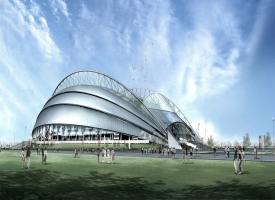Jul 25 2008
At this year’s summer Olympics in China, it’s not just the many athletes who need to be in top form.
 Makrolon® proved to be a particularly suitable material for the roof of the Olympic stadium in Shenyang because it is lightweight and easy to assemble.
Makrolon® proved to be a particularly suitable material for the roof of the Olympic stadium in Shenyang because it is lightweight and easy to assemble.
To qualify to take part in the Olympics, some of the materials incorporated into the stadiums also had to meet exceptional criteria. Makrolon® polycarbonate sheets from Bayer MaterialScience prevailed here with their excellent light transmission, exceptional flexural strength, low weight and durability. More than 36,000 square meters of this transparent semi-finished product was used to build various Olympic facilities in China.
The roof of the Olympic stadium in Shenyang for example is made of Makrolon®. It was constructed in form of wings representing elegance and lightness – the architectural vision in the construction of many Olympic stadiums. As well as the light weight of the multiwall sheets, their ease of assembly also proved to be a major advantage. It was possible simply to place the plastic sheets on a delicate substructure on-site using a cold bending process. For the Chinese, who coordinated all construction projects according to a strict schedule, this was particularly welcome. However, the critical factor when selecting materials was the minimal deflection value stipulated in the invitation to tender. In an extremely short time, a special sheet was developed that met the specifications. 25-millimeter-thick Makrolon® multi UV 3X/25-25 ES sheets, with a sheet span of 1.5 meters, can bear loads of over three kilonewtons per square meter and are therefore stable and secure, even in heavy snowfalls and strong winds. The Shenyang Olympic stadium has a roof and façade of Makrolon® covering an area of 21,530 square meters.
Makrolon® sheets in the Tianjin Olympic stadium form a transparent inner ring measuring approximately 13,000 square meters that covers part of the stands. A particularly notable feature here is the light transmission level of over 85 percent through the six millimeter-thick polycarbonate sheets. It was possible to build the stands close to the edge of the playing field without impairing grass growth, because a great deal of light can pass through the sheets. For a stadium where Olympic soccer games are to take place on natural grass, this is crucially important.
In addition to the two stadiums in Shenyang and Tianjin, the sailing center in Quingdao was also fitted with roofing made of Makrolon®, while curtain wall panels have been supplied for the weightlifting and gymnastics centers in Beijing.
The Chinese government has invested some USD 2.2 billion dollars in building new stadiums. The durability of materials used is therefore a key factor. Both athletes and spectators should be able to benefit from the stadiums for as long as possible without any loss of functionality and comfort. Makrolon® sheets also satisfy this requirement since they show scarcely any deterioration, even decades after being fitted.
For more information on polycarbonate, click here.
Posted July 25th,2008